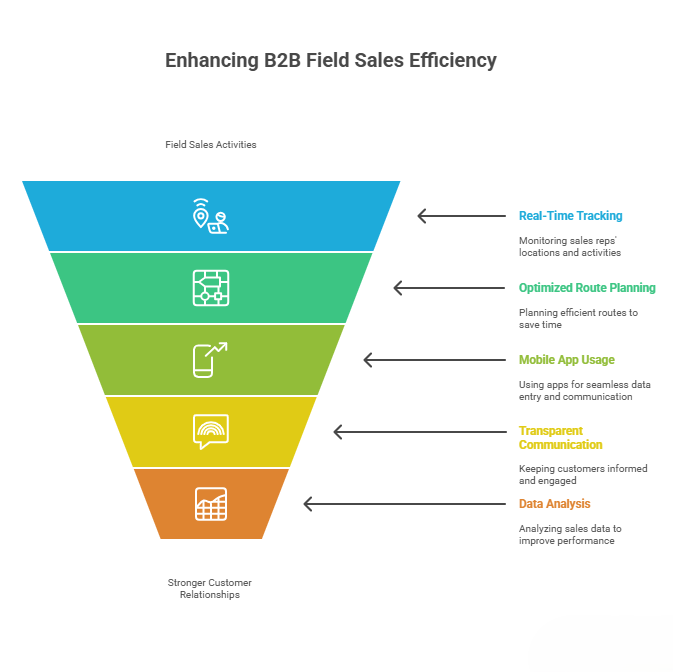5 Ways to Track Field Sales Without Losing Customer Relationships

Tracking field sales in a B2B business helps growth while keeping customer trust. In industries like medical supplies, sanitary ware, or electronics, field sales reps are often the main contact. Their interactions shape how customers see your company, so keeping an eye on their work is important. The key is tracking without damaging relationships. Sales depend on trust, and no system should get in the way of genuine connections between reps and clients. Successful businesses track their teams while keeping customer bonds strong.
Good tools let managers monitor field sales in real time, improve team productivity, and ensure customers get consistent service. This approach keeps operations smooth and supports lasting client relationships.
Why B2B Businesses Need to Track Field Sales Effectively?
B2B companies need to track field sales to understand their team’s work. Real-time tracking software shows managers how reps perform, where resources are needed, and if customer’s needs are met. It helps spot weak spots, improve regional coverage, and make smarter decisions about daily operations.
Tracking improves productivity. Sales reps can use mobile apps to log visits, update info, and stay organized on the go. Managers can check progress, see who needs training, and help the team do better. This makes managing multiple territories easier.
Route planning matters too. Optimized routes mean less travel time and more time with clients. This cuts costs, reduces delays, and ensures timely visits.
Tracking also builds stronger customer relationships. Missed visits or slow responses can hurt trust in B2B sales. Good tracking tools help businesses respond faster, follow up on time, and stay reliable. Consistent tracking fosters trust and supports long-term deals.
1. Implement Real-Time Field Sales Tracking for Better Productivity
Using real-time tracking helps managers see where field sales representatives are and what they are working on throughout the day. This makes planning visits easier, helps spot delays, and ensures reps spend more time with customers instead of on the road.
Smarter route planning reduces travel time and lets teams reach more clients efficiently. Sales reps using a mobile app can log visits, update notes, and stay organized while moving between locations.
Transparency is important. Customers should understand that optimized visits are meant to provide faster service and better attention, not to intrude on privacy. Clear communication builds trust and shows that efficiency and strong relationships matter.
Best practices
Use GPS data to plan routes that save time and increase face-to-face interactions
Explain to customers how optimized visits improve their service
Review tracking data regularly to improve sales performance tracking for field teams
2. Use Mobile Apps to Log Customer Interactions Seamlessly
sales, manage inventory, and record every interaction on the spot. With current data, reps can adjust their approach and improve service for each customer.
These apps also let managers track team performance. They can see which accounts need focus, how reps spend their time, and what strategies work. This keeps teams organized and ensures no customer gets missed.
Best practices
Pick apps that sync with your CRM for automatic data updates.
Train reps to use the app well and take advantage of its features.
Push for real-time data entry to keep customer info accurate.
Mobile apps streamline field sales, keep teams informed, and build stronger customer relationships.
3. Transparent Communication Boosts Customer Trust in Field Sales
Clear communication with customers builds trust. Regular updates about visits, product availability, or delays manage expectations. A simple feedback system lets customers share concerns quickly.
Automated notifications keep customers informed about visits or changes. Dedicated channels make it easy for clients to reach out and get fast responses. Reps should listen to concerns and act to improve service.
Open communication strengthens customer relationships and reduces problems. It helps managers track team performance by highlighting where service can improve and which interactions build loyalty.

4. Analyze Sales Data to Improve Team Performance and Coverage
Monitoring the performance of field sales teams through key metrics like sales volume, visit frequency, and customer satisfaction provides important insights. These numbers show where reps are performing well and where they may need support. By focusing on data, managers can make better decisions that improve results without hurting customer relationships.
Real-time tracking software and dashboards help managers see how teams perform. They can spot trends, find gaps in coverage, and guide reps to focus on key accounts. Reviewing data with reps sets clear goals and encourages steady improvement.
Best practices
Set clear KPIs tied to business goals.
Use simple dashboards or tools to make data clear.
Meet regularly with reps to review performance, celebrate wins, and find areas to improve.
Analyzing sales data helps track field team performance, improves coverage, and keeps teams efficient while maintaining strong customer ties
5.Customer-Centric Sales Approach
Focusing on customer needs builds strong relationships. Reps who understand client issues, offer solutions, and follow up earn trust. Including satisfaction in reviews shows relationships matter. Empathy and listening training improve communication. Recognizing good interactions motivates reps. A customer-focused approach with tracking keeps teams productive and strengthens client ties.
Key Points for Customer-Centric Sales
- Understand client issues and provide solutions.
- Follow up to build trust.
- Include satisfaction in reviews.
- Train reps in empathy and listening.
- Recognize good interactions.
- Combine customer focus with tracking.
What’s Next
Tracking field sales does not have to disrupt customer relationships. With the right tools, your field team can work efficiently while keeping clients satisfied. This approach boosts productivity and supports business growth.
Happisales Field Force Automation Software lets businesses track visits, orders, collections, and service tasks in real time, even offline. It gives managers clear insights into field operations while helping teams maintain strong customer connections.
You can start a 14-day free trial or request a personalized live demo to see how the platform fits into your workflow.
Frequently asked questions
1. How to keep track of customer interactions?
The easiest way is to use a mobile app or CRM where reps can log visits and notes right after meeting a client. This keeps all details in one place, avoids missed follow-ups, and gives managers a clear picture of what’s happening with each customer.
2. How to track sales rep activity without breaking the budget?
You don’t need expensive software to track your team. Affordable sales apps can show visits, orders, and daily activity in real time. Features like route planning save fuel and time, so you get better results without overspending.
3. How can businesses track field sales without losing customer trust?
It comes down to being transparent. Customers are usually fine with tracking if they know it helps you reach them on time and respond faster. When reps show up consistently and follow up properly, tracking feels like better service-not surveillance.
4. How does route optimization improve sales productivity?
Smart route planning helps reps cut down on travel time and meet more customers in a day. It also reduces costs like fuel and delays. For clients, this means timely visits and smoother service, which builds trust.
5. How can managers use sales data to improve team performance?
Looking at data like visits, orders, and response times helps managers spot what’s working and what’s not. Instead of guesswork, they can give clear feedback, guide reps to focus on the right accounts, and celebrate wins. This makes the team more focused and effective.

